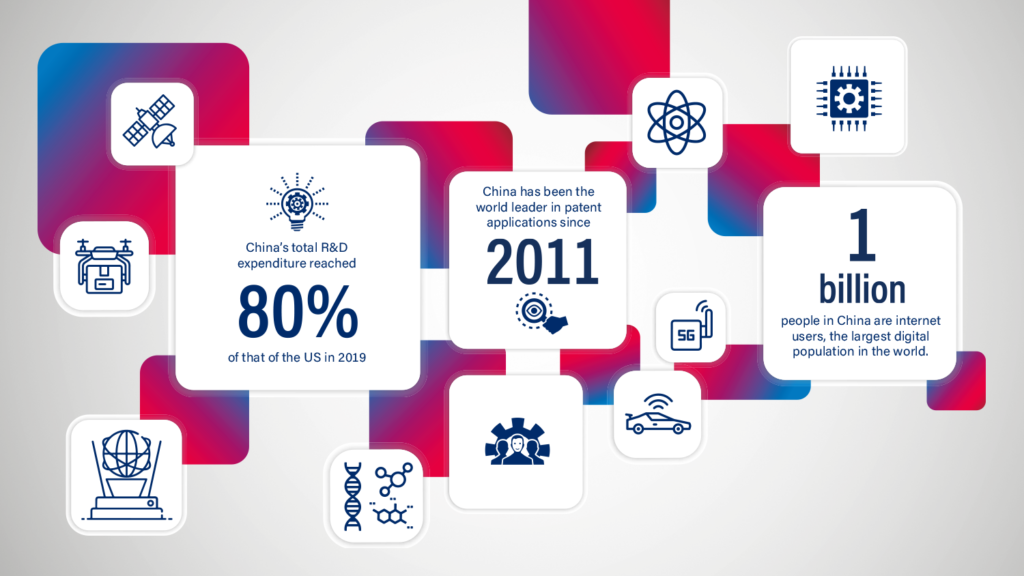
China’s rapid innovation ecosystem
‘China speed’ has been used to describe the inordinate pace of the country’s development over past decades, with skyscrapers, super-speed trains and even COVID-19 hospitals seemingly popping up overnight. In recent times, the phrase has been adopted to refer to the pace of innovation compared to that in Europe, particularly in industries such as artificial intelligence, new technologies and the Internet of Things. Hania Thurlow, project manager at the European Chamber, explains more.
Since China began to reform its economy and open up four decades ago, its gross domestic product (GDP) grew from around United States dollars (USD) 360 billion in 1978 to almost USD 16 trillion in 2021.[1] China’s annual GDP growth rate has been over nine per cent on average,[2] well above the world economy average of four per cent over the same period.[3] The World Bank had described China’s growth as “the fastest sustained expansion by a major economy in history”.[4]
Shenzhen is a commonly used example of this transformation. Riding on the back of a wave of economic reforms, a sleepy fishing village with a population of just tens of thousands transformed into a booming metropolis with more than 10 million inhabitants in just 40 years.[5] This fast pace of economic development is evident across China, particularly on the east coast.
China’s innovation ecosystem
Today, ‘China speed’ no longer simply reflects the country’s economic prowess or the startling pace of infrastructure development, but the future of China’s innovation ecosystem.

Research and development (R&D) is the backbone of innovation, supporting the creation of new products and services.[6] In 2020, China’s gross domestic R&D expenditure was significantly higher than EU Member States and second only to the US.[7] To get a better idea of the pace of R&D growth, China’s total R&D expenditure reached 80 per cent of that of the US in 2019, up from 26 per cent in 2005.[8] Patents are another key innovation indicator. China has been the world leader in patent applications since 2011, according to the World Intellectual Property Organization (WIPO).[9]
‘Imitator’ to global innovator
In fact, a report by the Information Technology and Innovation Foundation (ITIF) published in November 2022 found that, based on key indicators of innovation and advanced industry capabilities, China has surpassed the US in total innovation output. In the decade up to 2020, China’s output increased from approximately 78 per cent to 139 per cent of that of the US (in absolute terms).[10]
Up until recently, ‘China speed’ in innovation referred to how quickly China was able to imitate innovations from elsewhere, rather than domestic inventions. However, the progress made against the US market, even when accounting for size, shows that China is swiftly becoming an innovator in its own right.[11] According to the ITIF, China’s ability to bring an invention to market and commercialise it faster than anywhere else in the world has the potential to define the global innovation ecosystem for decades to come. [12]
With such progress being made, the ‘China speed’ approach to innovation is increasingly important for those doing business in China to understand.
‘China speed’ is embedded in Chinese business culture
According to the head of a Shanghai-based R&D division of a major multinational, one reason for the growing success of ‘China speed’innovation is that it is ingrained in today’s local business culture. Decisions that could take weeks or months to action by European companies can be turned into prototypes and tested within days in China, a key differentiating factor from European and US markets. But why is China uniquely positioned for this accelerated decision-making and innovation?
After the tremendous economic growth of the past decades, adaptability has played an integral role in China’s economic development. In a rapidly changing environment, consumers are more open for solutions to make their lives more convenient and help adapt to the changes.[13] For example, take the rate of digital adoption in China. It has the largest digital population in the world, estimated at over a billion internet users.[14] In the EU, mobile payments accounted for eight per cent of all point-of-sale transactions in 2022.[15] In China, was is over 40 per cent.[16]
China has adopted its own version of the ‘fail fast, fail forward’ approach – one where innovative solutions can be tested on a huge population that is generally much more open to change. Although the trend is beginning to shift, the Chinese population has historically been much more willing to provide their data in exchange for convenience.[17] The result: the ability to quickly generate huge amount of data and use this to react to market changes and continuously improve technology.
This continuous iteration is essential for speedy innovative results. Having seen such rapid economic development in their lifetime, Chinese consumers have high expectations that this will continue at the same pace.[18] For a brand to offer just one new model or software update annually—as is often the case in Europe—is not enough.[19] Businesses targeting the Chinese market need to be constantly redeveloping to stay ahead of the competition. As a result, Chinese enterprises are much less risk averse and able to act a lot faster to any opportunity or threat.
Unlike Europe or the US, China is able to actively anticipate and compartmentalise rapidly so that development can happen in parallel and new technology can immediately be taken advantage of.[20]
Importance for doing business in China
China’s Innovation System: The Localisation Dilemma by the European Chamber with the Mercator Institute for Chinese Studies (MERICS), surveyed European member companies engaged in R&D in China. It showed that 39 per cent of respondents saw the fast pace of commercial application of R&D results as an advantage, and was seen as a key incentive for having R&D operations in the country. For some, R&D in China is essential in order to be able to compete with domestic rivals on the global market.[21]
Of the respondents surveyed, 61 per cent said that they valued the size of the market, and 47 per cent felt the positive impacts of strong appetite for their innovation. These advantages mean quicker breakthroughs in technological development and refinement of operations that can then be applied back home.
Speed isn’t everything
Rapid development comes at an expense. European companies have not been immune to the negative consequences of participating in China’s innovation ecosystem. Those surveyed highlighted weak intellectual property rights (IPR) protection systems (34 per cent); an un-level playing field for foreign companies (32 per cent); insufficient local talent (29 per cent); and too much market competition (28 per cent) as specific challenges.
For example, despite the enforcement of IPR being noted as one of Shanghai’s strengths, the risk of IP infringement remains the leading reason why local Chamber members remain reluctant to bring their latest technology to China.[22]
Conclusion
Even if China can fix some of these domestic challenges, issues undermining international collaboration remain. Global opinions of China have soured over recent years,[23] and geopolitical tensions is the most likely issue that could cut China off from of the global innovation ecosystem.[24] Engaging in innovation with China may get increasingly difficult if these tensions continue to intensify.
European
businesses are right to recognise the benefit of ‘China speed’ and the advantages
for global innovation ecosystem. Those already engaging in R&D in China can
see the advantages, even if it is just by observing the sheer speed and scale
of developments. Only time will tell whether ‘China speed’ will continue to
dominate the country’s development for the next few decades.
[1] GDP (constant 2015 US$) – China, World Bank, 2021, viewed 10th March 2023, <https://data.worldbank.org/indicator/NY.GDP.MKTP.KD?end=2021&locations=CN&start=1978>
[2] The World Bank in China, World Bank, 29th September 2022, viewed 10th March 2023, <https://www.worldbank.org/en/country/china/overview>
[3] GDP growth (annual %), World Bank, 2021, viewed 10th March 2023, <https://data.worldbank.org/indicator/NY.GDP.MKTP.KD.ZG?start=1978>
[4] China’s Economic Rise: History, Trends, Challenges, and Implications for the United States, Congressional Research Service, 25th June 2019, viewed 10th March 2023, <https://sgp.fas.org/crs/row/RL33534.pdf>
[5] Wasserstrom, Jeffery N.,‘The Shenzhen Experiment’ Review: Building up a ‘Fishing Village’, The Wall Street Journal, 22nd January 2022, viewed 16th March 2023, <https://www.wsj.com/articles/the-shenzhen-experiment-review-building-up-a-fishing-village-11579735008>
[6] Is China a Global Leader in Research and Development?, China Power, 28th January 2021, viewed 13th March 2023,<https://chinapower.csis.org/china-research-and-development-rnd/>
[7] Gross domestic spending on R&D (indicator), OECD, 2023, viewed 17th March 2023, <https://www.oecd-ilibrary.org/industry-and-services/gross-domestic-spending-on-r-d/indicator/english_d8b068b4-en>
[8] OECD Main Science and Technology Indicators: Highlights on R&D expenditure, March 2021 release, OECD, March 2021, viewed 14th March 2023, <https://www.oecd.org/sti/msti-highlights-march-2021.pdf>
[9] World Intellectual Property Indicators 2020, World Intellectual Property Organization, 2020, viewed 16th March 2023, <https://www.wipo.int/edocs/pubdocs/en/wipo_pub_941_2020.pdf>
[10] Clay, Ian & Atkinson, Robert, Wake Up, America: China is Overtaking the United States in Innovation Capacity, Informational Technology and Innovation Foundation, 23rd January 2023, viewed 10th March 2023, <https://itif.org/publications/2023/01/23/wake-up-america-china-is-overtaking-the-united-states-in-innovation-capacity/>
[11] China’s economic power on uncertain speed, European Commission Competence Centre on Foresight, 5th October 2022, viewed 13th March 2023, <https://knowledge4policy.ec.europa.eu/foresight/chinas-economic-power-uncertain-speed_en>
[12] Clay, Ian & Atkinson, Robert, Wake Up, America: China is Overtaking the United States in Innovation Output, Informational Technology and Innovation Foundation, November 2022, viewed 10th March 2023, <https://www2.itif.org/2023-us-v-china-innovation.pdf>
[13] Dychtwald, Zak, China’s New Innovation Advantage, Harvard Business Review, June 2021, viewed 10th March 2023, <https://hbr.org/2021/05/chinas-new-innovation-advantage>
[14] Milasevic, Marija & Hofer, Maxim, Digital Living: Who are the Next Billion Internet Users?, Euromonitor International, 12th December 2022, viewed 14th March 2023, <https://www.euromonitor.com/article/digital-living-who-are-the-next-billion-internet-users>
[15] Fleck, Anna, Mobile Payments: Asia Far Ahead in Mobile Payment Adoption, Statista, 31st August 2022, viewed 14th March 2023, <https://www.statista.com/chart/28128/mobile-payments-around-the-world/>
[16] Buchholz, Katharina, Mobile Payments: China’s Mobile Payment Adoption Beats All Others, Statista, 8th July 2022, viewed 14th March 2023, <https://www.statista.com/chart/17909/pos-mobile-payment-user-penetration-rates/>
[17] Wright, Andrew, This is how China’s economy has changed in the last 10 years, World Economic Forum, 22nd June 2016, viewed 17th March 2023, <https://www.weforum.org/agenda/2016/06/how-has-china-s-economy-changed-in-the-last-10-years/>
[18] Future of Consumption in Fast-Growth consumer Markets: China, World Economic Forum, January 2018, viewed 15th March 2023, <https://www3.weforum.org/docs/WEF_Future_of_Consumption_in_Fast_Growth_Consumer_Markets_China.pdf>
[19] Dychtwald, Zak, China’s New Innovation Advantage, Harvard Business Review, June 2021, viewed 10th March 2023, <https://hbr.org/2021/05/chinas-new-innovation-advantage>
[20] Ibid.
[21] China’s Innovation Ecosystem: The Localisation Dilemma, European Chamber of Commerce in China and MERICS, April 2022, <https://www.europeanchamber.com.cn/en/publications-innovation-report>
[22] Shanghai Position Paper 2023/2024, European Chamber of Commerce in China, 14th February 2023, viewed 14th February 2023, <https://www.europeanchamber.com.cn/en/publications-archive/1073/Shanghai_Position_Paper_2023_2024>
[23] Pomfret, James, Opinion of China in advanced economies sours ‘precipitously’ under Xi – Pew, Reuters, 29th September 2022, viewed 16th March 2023, <https://www.reuters.com/world/china/opinion-china-advanced-economies-sours-precipitously-under-xi-pew-2022-09-29/>
[24] Lau, Joyce, Is China open to adopting a culture of innovation, Nature, 7th December 2022, viewed 16th March 2023 <https://www.nature.com/articles/d41586-022-04207-0>


Recent Comments